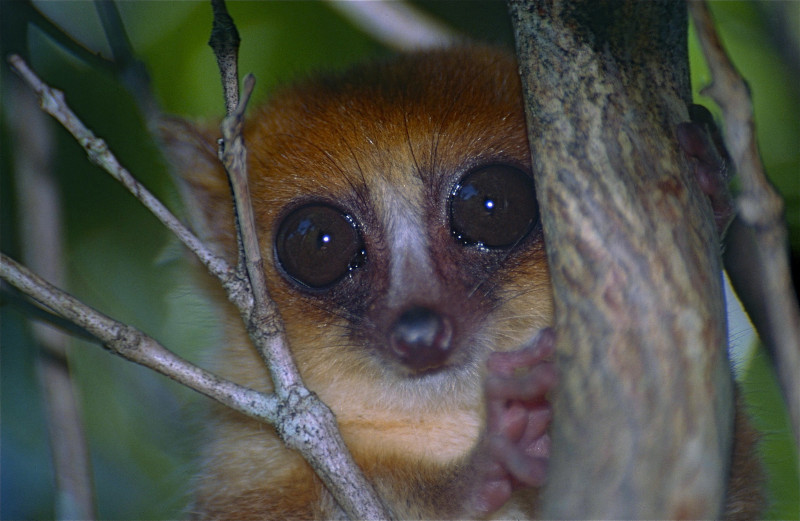
Gray Mouse Lemur Facts
- This distinctive creation of Nature and evolution most often goes by the descriptive common name of the Gray Mouse Lemur. Yet the animal also has a few other general titles, as well. These includes the very similar term of lesser mouse lemur, among several others.
- Within the scientific community, however, it’s perhaps much better known by its technical appellation. Like most such titles, though, that’s somewhat hard for the layperson to pronounce. That’s because this mammal holds the formal moniker Microcebus murinus.
- The animal received that name due to the efforts of John Frederick Miller. Though not a scientist, the British illustrator nevertheless achieved credited for the first recognition of it as a separate and distinct species. That scientifically noteworthy event occurred in the year 1777.
- The intriguing Gray Mouse Lemur inhabits a limited range, and quite sadly, its population numbers appear to be diminishing, albeit slowly. Despite that, the IUCN currently lists it as Least Concern on its Red List. That official status might change in the very near future, though.
- The species presently face multiple threats to its continued existence in the wild. At present, its most immediate threat comes from habitat loss due to human activities. Yet the natural marvel also now faces the same looming threat of ongoing climate change as all species do.
Related Articles
Gray Mouse Lemur Physical Description
The magnificent Gray Mouse Lemur truly earns the level of appreciation it receives from those individuals fortunate enough to encounter it. The creature does so, though, due to a unique combination of factors. Intriguingly, each of those features pertain to its physical characteristics.
Most lemurs display no noticeable amount of gender-based physical differences. This remarkable species, however, does so. Yet it also manages to do it due to a combination of two very specific traits. This results in a truly intriguing display of the physiological trait of sexual dimorphism.
Incredibly, the female of the species develops a slightly larger head than that of her male counterpart. This part of their body tends to develop as both higher and wider than that of the males. These additionally typically attain a marginally greater average weight than that sex.
Otherwise, both genders of the fascinating small primate attain the same general outward appearance. Amazingly, its head-and-body length only reaches a mean measurement equaling approximately 4.7-5.5 in (12-14 cm). The tail further adds another 5.1-5.7 in (13-14.5 cm) to this.
The mass of the Gray Mouse Lemur additionally varies significantly by season. This natural pattern holds equally true for both sexes. Throughout the course of the year, though, an average weight totals approximately 2.1 oz (60 g). Exceptional specimens do occur, though, of both genders.
Given these remarkably tiny measurements, the wonder easily qualifies as one of the smallest of all known primates in the world. Yet, it’s simultaneously the largest of all presently identified species of mouse lemur. As stated previously, it therefore holds a unique status in the animal world.
In all other respects, though, males and females alike display the same general appearance. The fur on the upper back typically shows a light brownish-gray shade, with some reddish hues present. The sides, however, show beige or light gray, while the rest of the body manifests a dull white color.
- Kingdom: Animalia
- Phylum: Chordata
- Class: Mammalia
- Order: Primates
- Family: Cheirogaleidae
- Genus: Microcebus
- Species: M. murinus
Gray Mouse Lemur Distribution, Habitat, and Ecology
The astounding Gray Mouse Lemur evolved as native to a highly limited portion of the surface of the world. Yet that region suits it perfectly, as it’s also home to a large number of other remarkable forms of life. That’s because it developed as solely endemic to the island of Madagascar.
Geographically situated near the continent of Africa, this site abounds with natural wonders. But, even on this island the mammal only makes its home in certain sections. To date, the grand work of Nature’s only known to inhabit the most southern and western regions of the large isle.
Unlike like many species across the globe, this mammal displays an impressive versatility regarding its choice of habitat. In fact, it seems to be one of the most flexible in this regard of all known lemurs. This represents one of the factors aiding in its survial, despite its relatively low numbers.
It primarily chooses to reside in various types of lowland forest. This includes such diverse ecosystems as gallery forests, scrub forests, secondary forests, and tropical one’s, as well. It also sporadically dwells in areas of dry habitat, degraded habitats, and sometimes even plantations.
Following the pattern of all its kindred, the Gray Mouse Lemur lives as both a nocturnal and arboreal creature. It’s typically highly active, and in all aspects off its overall nature. During the day, however, it often gathers in small groups for sleeping purposes, often in holes in trees.
It evolved to feed omnivorously, mainly consuming various local flowers, nectar, and fruit. Small numbers of insects occasionally augment this. Astonishingly, it’s also been seen to kill and eat its own kind in times of need! Its own predators include snakes, owls, and other, larger mammals.
Species Sharing Its Range
Check out our other articles on 7 Astounding Polar Creatures, Northern Hairy Nosed Wombat, Okefenokee Swamp, Yunnan Golden Monkey, Cheddar Pink, Blue-lipped sea krait
